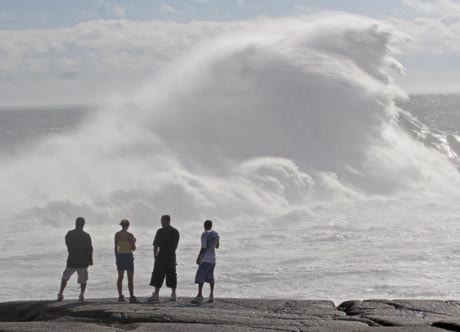PORT HAWKESBURY, N.S. — Hurricane Bill was on Dan Stewart’s tail as he drove his tractor-trailer from Halifax to Cape Breton on Sunday, but the seasoned driver from Nova Scotia’s Annapolis Valley said the big storm wasn’t a big deal.
“We missed the brunt of it,” Stewart said with a shrug before getting a coffee at a Tim Hortons in Port Hawkesbury, a few minutes drive from the Canso Causeway, the gateway to Cape Breton.
“I don’t think we got the full hit. Thank goodness.”
All along Nova Scotia’s Atlantic coast, the Category 1 hurricane delivered steady downpours and strong winds, knocking out power, forcing cancellations of flights and events, and drawing onlookers hoping to catch a glimpse of crashing waves.
Bill ripped the branches from trees in Halifax and elsewhere, and there was some localized flooding.
But the storm did not appear to cause much damage as its eye remained off the coastline before heading for the south coast of Newfoundland in a weakened state.
Peter Bowyer of the Canadian Hurricane Centre said the hurricane packed sustained winds of 120 kilometres an hour over the ocean but the highest gust on land by late afternoon was a less threatening 87 km/h outside Halifax.
He said it could have been much worse.
“I’d love for people to realize that this was a very near-miss for a full-fledged hurricane hit in Nova Scotia,” he said. “This storm only had to track 60 or 70 kilometres farther west (and) we’d be having a whole different conversation right now.”
Stewart, a driver for Ayr Motor Express in Woodstock, N.B., said Bill was nasty, but not that mean.
“It reminds me of some of the winter storms I’ve seen,” he said. “I’m glad it’s not snow. It’s certainly some big wind.”
Meteorologists had warned that the eastern mainland of Nova Scotia and southern Cape Breton would bear the brunt of the storm.
But Shirley Matheson, a resident of Port Hawkesbury, said the storm let her down.
“It’s kind of disappointing,” she said as the wind howled through the swirling curtains of rain lashing a busy parking lot. “We’re glad no one is getting hurt or anything, but we’re used to this.”
Despite repeated warnings to keep away from the turbulent ocean, many people wanted to get a close-up view of the swirling tropical menace. Many ventured onto the bald rocks at Peggy’s Cove, N.S., some of them dangerously close.
Shortly before 6 p.m., three young men were swept off the rocks at the famed Peggy’s Cove lighthouse. As horrified onlookers watched, one of the men went under the churning sea but was pulled out by his buddies and the three were able to scramble to safety.
“Very lucky, I’ll tell you. And they know it,” said RCMP Const. Joe Taplin. “The big guy who went under the water is very shook up.”
Taplin said officers spent the day chasing people off the rocks at the popular tourist spot, as well as swimmers and surfers from beaches along the coast.
“It’s been a running battle all day,” he said.
Some hurricane watchers in Maine weren’t as lucky as the trio in Nova Scotia.
Three people at Acadia National Park were swept off rocks by a wave, triggering a coast guard search. There was no word on their fate by nightfall. Two others were rescued.
Gawkers were also out along the boardwalk in downtown Halifax as swells grew steadily in strength and size.
“So far, it’s pretty wild,” said Heather Wright as she walked along the edge of Halifax harbour.
“We’re not going right to the edges or nothing. And we’re here mainly to sightsee a bit and go back home and ride it out.”
Bowyer, a program supervisor at the hurricane centre, repeatedly warned people to stay away from the water.
“If you want to enjoy them, enjoy them from a distance,” he said of the huge ocean swells. “Do not enjoy them up close and personal because your enjoyment can end very quickly.”
Bill’s quick advance forced the cancellation of dozens of flights throughout the Atlantic region, including airports in Halifax and Moncton, N.B.
Power outages were reported throughout Nova Scotia, affecting more than 40,000 customers at one point, according to Nova Scotia Power. But power was gradually restored to many customers throughout the day.
Some roads, including the one to Peggy’s Cove, were temporarily closed.
Bill heaved some rocks onto a few other coastal roads, but they were soon cleaned up.
As the storm moved north, Marine Atlantic cancelled its ferry runs between Nova Scotia and Newfoundland, and public beaches and parks throughout Nova Scotia were closed.
A weather buoy about 200 km southeast of Yarmouth, N.S., recorded a wave peaking at 26.4 metres.
Bowyer said Yarmouth received the most rainfall in the region at 65 millimetres while southern New Brunswick reported a high of 38 mm in St. Stephen. Parts of Prince Edward Island received at least 30 mm.
Craig MacLaughlan, CEO of Nova Scotia’s Emergency Management Office, said though no major damage was reported, there were cases of localized flooding along the South Shore and in the Lawrencetown area east of Halifax.
“I think we can be blessed that it has moved off a bit and that we’re not getting some of the damage that we thought (we would),” MacLaughlan said.
The storm was expected to make landfall over southeastern Newfoundland late Sunday or early Monday as a strong tropical storm, with winds of at least 70 km/h.
